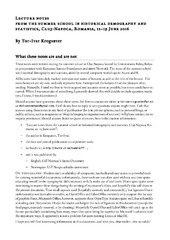| dc.contributor.advisor | Blix Hagen, Rune | |
| dc.contributor.author | Hegsvold Sørlie, Haakon | |
| dc.date.accessioned | 2022-05-25T05:33:13Z | |
| dc.date.available | 2022-05-25T05:33:13Z | |
| dc.date.issued | 2020-05-25 | en |
| dc.description.abstract | This dissertation investigates the role of the clergymen in Finnmark in the witchcraft prosecutions that took place in the region from 1620–1692. The dissertation builds on a large amount of primary evidence from both judicial and ecclesiastical archives. The topic is approached through a qualitative critical contextual reading of the sources, this strong basis in the sources enables an investigation into the role of the clergy both inside and outside of the prosecutions. The dissertation argues that the clergy had two roles, one was clearly religious and was concerned with the salvation of the sentenced person’s soul. The other was of a more secular nature and was concerned with interrogating and questioning of the accused, but both these roles experienced development and nuance throughout the period. These two roles were not fulfilled by all the clergymen, as the study has found that there was a somewhat frequent deviation between normative regulation and praxis among the clergymen in Finnmark. This difference between norm and praxis is also evident in the clergy’s role in the prosecutions, as this dissertation nuances the established view that the clergymen acted as a united group in demonizing popular culture. The study has found that only a minority of the clergymen in Finnmark had attended university in the seventeenth century, this resulted in a hybrid understanding of witchcraft among the clergymen that accepted elements of both diabolism and maleficium. In addition, the clergy had a heterogenous approach to witchcraft, some clergymen never prosecuted rumoured witches, others gave impetus to the trials, and some attempted to punish the witches through alternative methods such as church discipline. The argument that the clergymen involved themselves in the trials in their role as state officials is also nuanced, although the self-regulatory relationship between priest and parishioners disappeared during the prosecutions, there is clear evidence that some clergymen had personal incentives when they involved themselves in the prosecutions. | en_US |
| dc.identifier.uri | https://hdl.handle.net/10037/25276 | |
| dc.language.iso | eng | en_US |
| dc.publisher | UiT Norges arktiske universitet | no |
| dc.publisher | UiT The Arctic University of Norway | en |
| dc.rights.holder | Copyright 2020 The Author(s) | |
| dc.rights.uri | https://creativecommons.org/licenses/by-nc-sa/4.0 | en_US |
| dc.rights | Attribution-NonCommercial-ShareAlike 4.0 International (CC BY-NC-SA 4.0) | en_US |
| dc.subject.courseID | HIS-3900 | |
| dc.subject | VDP::Humanities: 000::History: 070::Recent history (before 1800): 082 | en_US |
| dc.subject | VDP::Humaniora: 000::Historie: 070::Nyere tids historie (før 1800): 082 | en_US |
| dc.subject | VDP::Humanities: 000::History: 070::Cultural history: 075 | en_US |
| dc.subject | VDP::Humaniora: 000::Historie: 070::Kulturhistorie: 075 | en_US |
| dc.subject | VDP::Humanities: 000::History: 070::Social history: 072 | en_US |
| dc.subject | VDP::Humaniora: 000::Historie: 070::Sosialhistorie: 072 | en_US |
| dc.title | Between Heaven and Hell: The role of the clergy in the witchcraft prosecutions in Finnmark, 1620-1692 | en_US |
| dc.type | Mastergradsoppgave | no |
| dc.type | Master thesis | en |


 English
English norsk
norsk



